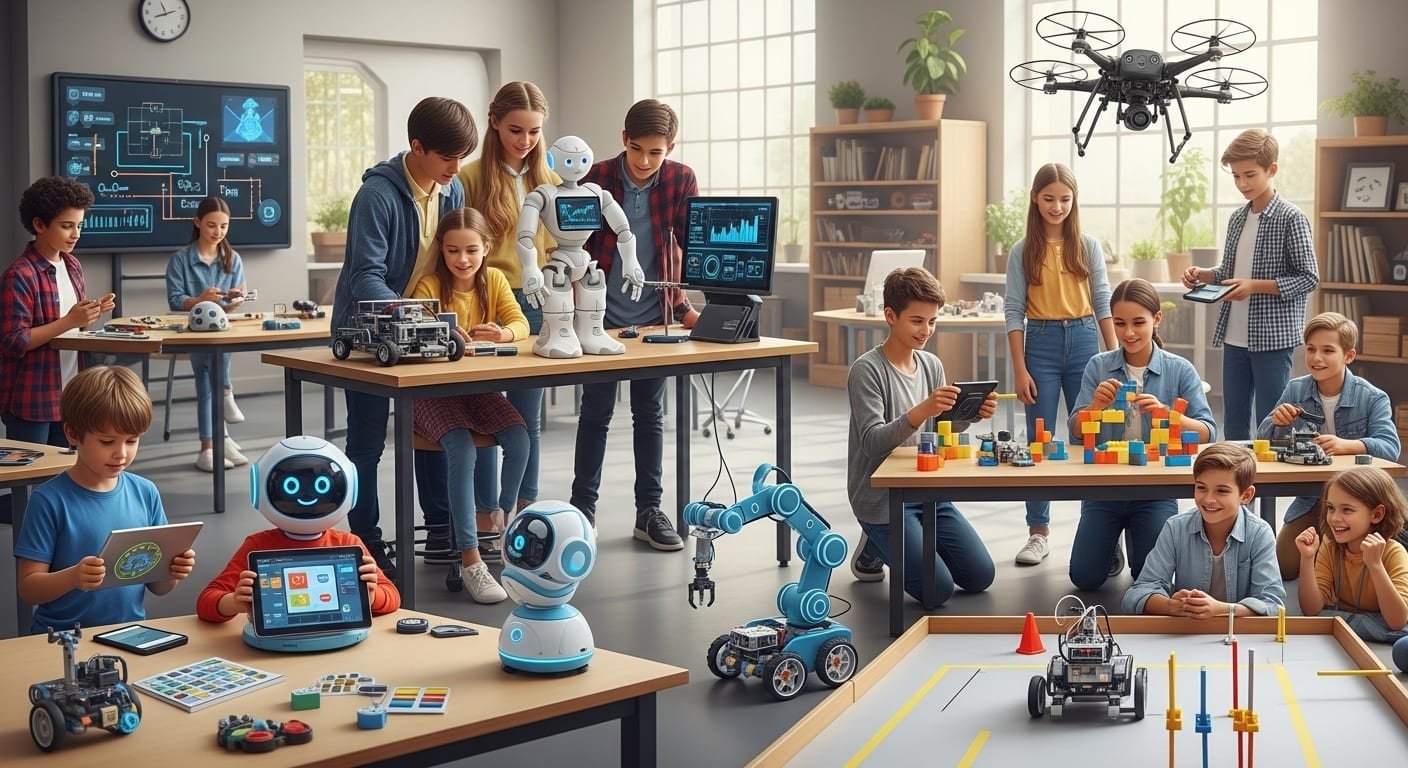AI Research
Educational Robot Market Size to Reach $5.9B by 2033: Growth Trends & Market Scope

Market Overview:
According to IMARC Group’s latest research publication, “Educational Robot Market by Component (Hardware, Software), Product Type (Humanoid, Non-Humanoid), End-User (K-12, Universities, and Others), and Region 2025-2033“, the global educational robot market size reached USD 1.9 Billion in 2024. Looking forward, IMARC Group expects the market to reach USD 5.9 Billion by 2033, exhibiting a growth rate (CAGR) of 13.6% during 2025-2033.
This detailed analysis primarily encompasses industry size, business trends, market share, key growth factors, and regional forecasts. The report offers a comprehensive overview and integrates research findings, market assessments, and data from different sources. It also includes pivotal market dynamics like drivers and challenges, while also highlighting growth opportunities, financial insights, technological improvements, emerging trends, and innovations. Besides this, the report provides regional market evaluation, along with a competitive landscape analysis.
How AI is Reshaping the Future of Educational Robot Market
- Generative AI is revolutionizing education by creating intelligent, adaptive learning companions that enhance the student experience, with AI teachers offering personalized learning paths that adjust content delivery based on individual student needs, transforming traditional classroom interactions through sophisticated machine learning algorithms that analyze student performance in real-time.
- Machine learning systems are dramatically improving educational engagement and retention rates, with advanced AI-powered robots now capable of recognizing student emotions and adjusting teaching approaches accordingly, leading to improved learning outcomes across diverse age groups and educational levels in schools worldwide.
- AI and machine learning are making robots smarter and more versatile, enabling educational robots to process complex student queries instantly, adapt curriculum delivery methods, and provide immediate feedback through natural language processing capabilities that make learning more interactive and effective.
- Strategic partnerships between technology companies and educational institutions are accelerating innovation, with major robotics firms collaborating with schools to develop specialized educational content, while universities integrate programmable robots for advanced research purposes and hands-on learning experiences that prepare students for future careers.
- Universities are using programmable robots for research purposes, driven by integration of artificial intelligence technology and hands-on learning approaches, enabling students to gain practical experience with cutting-edge robotics technology while conducting advanced research projects that push the boundaries of educational innovation.
Get Your Free “Educational Robot Market” Sample PDF Report Now!
Key Trends in the Educational Robot Market
- Hardware components dominate the market landscape, capturing the largest market share as educational institutions prioritize tangible, interactive learning tools that students can physically manipulate, with schools investing heavily in durable robotic platforms that withstand classroom environments while delivering consistent educational value.
- Non-humanoid robots lead the product segment transformation, representing the majority market share as educators favor specialized teaching robots designed for specific subjects like mathematics, science, and coding, offering cost-effective solutions that focus on educational functionality rather than human-like appearance or social interaction capabilities.
- The K-12 education segment drives market expansion, accounting for the largest end-user share due to growing recognition of STEM education importance, with elementary and secondary schools increasingly adopting robotic teaching tools to enhance student engagement in science, technology, engineering, and mathematics subjects.
- The secondary education segment held the largest share of 39.3% in 2024, as middle and high schools use more educational robots where students learn complex STEM concepts, including robotics, coding, engineering, and artificial intelligence, demonstrating the effectiveness of hands-on robotic learning in advanced educational settings.
- Asia Pacific regional dominance continues strengthening, holding the largest market share due to substantial government investments in educational technology, high smartphone penetration rates that complement robotic learning platforms, and strong cultural emphasis on technological advancement in education systems across countries like China, Japan, and South Korea.
Growth Factors in the Educational Robot Market
- Digital transformation acceleration is reshaping classroom experiences, with educational institutions rapidly adopting interactive robotic teaching assistants that deliver personalized instruction, while advanced sensors and AI capabilities enable robots to assess student understanding in real-time and adjust lesson difficulty accordingly for optimal learning outcomes.
- STEM education initiatives are creating unprecedented demand opportunities, as governments worldwide mandate science, technology, engineering, and mathematics curriculum improvements, with educational robots providing hands-on learning experiences that make complex concepts more accessible and engaging for students across all grade levels.
- Remote learning capabilities are expanding market applications significantly, with educational robots offering consistent teaching quality regardless of physical location, enabling schools to maintain educational continuity during disruptions while providing students with interactive learning experiences that traditional online education methods cannot deliver effectively.
- Cost-effectiveness advantages are driving institutional adoption decisions, as educational robots eliminate recurring expenses associated with traditional teaching materials, provide long-term educational value through software updates and curriculum expansions, while offering scalable solutions that serve multiple classrooms and subjects simultaneously.
- Workforce preparation demands are accelerating market growth, with educational institutions recognizing the critical need to prepare students for technology-driven careers, while robotic programming and interaction skills become essential competencies for future employment in increasingly automated industries and emerging technology sectors.
Ask analyst of customized report: https://www.imarcgroup.com/request?type=report&id=1900&flag=E
Leading Companies Operating in the Global Educational Robot Market Industry:
- Adele Robots
- Aisoy Robotics
- Arrick Robotics
- Blue Frog Robotics
- DST Robot Co.
- Hanson Robotics
- Idmind
- Macco Robotics
- Pal Robotics
- Primo Toys
- Probotics America
- Qihan Technology Co.
- Robobuilder
- Robotis
- Softbank Robotics Corp.
Educational Robot Market Report Segmentation:
Breakup by Component:
Breakup by Product Type:
Breakup by End-User:
Regional Insights:
- North America (United States, Canada)
- Asia Pacific (China, Japan, India, South Korea, Australia, Indonesia, Others)
- Europe (Germany, France, United Kingdom, Italy, Spain, Russia, Others)
- Latin America (Brazil, Mexico, Others)
- Middle East and Africa
Recent News and Developments in Educational Robot Market
- January 2025: SoftBank Robotics announced expanded educational partnerships with over 500 schools globally, deploying humanoid robots in classrooms to assist with language learning and social skill development, while integrating advanced AI capabilities that adapt teaching methods based on individual student progress and engagement levels.
- February 2025: Leading educational technology companies launched collaborative initiatives with universities to develop specialized robotic teaching assistants for STEM subjects, focusing on personalized learning experiences that combine artificial intelligence with hands-on robotics training for students pursuing engineering and technology degrees.
- March 2025: Government education departments in several Asian countries announced substantial funding increases for educational robotics programs, allocating resources to equip thousands of schools with interactive teaching robots designed to enhance science and mathematics instruction while preparing students for technology-focused careers.
- January 2025: Major robotics manufacturers introduced new cost-effective educational robot models specifically designed for K-12 institutions, featuring simplified programming interfaces, enhanced safety features, and comprehensive curriculum packages that enable teachers to integrate robotic learning across multiple subjects without requiring extensive technical expertise.
Research Methodology:
The report employs a comprehensive research methodology, combining primary and secondary data sources to validate findings. It includes market assessments, surveys, expert opinions, and data triangulation techniques to ensure accuracy and reliability.
Note: If you require specific details, data, or insights that are not currently included in the scope of this report, we are happy to accommodate your request. As part of our customization service, we will gather and provide the additional information you need, tailored to your specific requirements. Please let us know your exact needs, and we will ensure the report is updated accordingly to meet your expectations.
About Us:
IMARC Group is a global management consulting firm that helps the world’s most ambitious changemakers to create a lasting impact. The company provide a comprehensive suite of market entry and expansion services. IMARC offerings include thorough market assessment, feasibility studies, company incorporation assistance, factory setup support, regulatory approvals and licensing navigation, branding, marketing and sales strategies, competitive landscape and benchmarking analyses, pricing and cost research, and procurement research.
Contact Us:
IMARC Group
134 N 4th St. Brooklyn, NY 11249, USA
Email: [email protected]
Tel No:(D) +91-120-433-0800
United States: +1-201-971-6302
AI Research
(Policy Address 2025) HK earmarks HK$3B for AI research and talent recruitment – The Standard (HK)
AI Research
[2506.08171] Worst-Case Symbolic Constraints Analysis and Generalisation with Large Language Models

View a PDF of the paper titled Worst-Case Symbolic Constraints Analysis and Generalisation with Large Language Models, by Daniel Koh and 4 other authors
Abstract:Large language models (LLMs) have demonstrated strong performance on coding tasks such as generation, completion and repair, but their ability to handle complex symbolic reasoning over code still remains underexplored. We introduce the task of worst-case symbolic constraints analysis, which requires inferring the symbolic constraints that characterise worst-case program executions; these constraints can be solved to obtain inputs that expose performance bottlenecks or denial-of-service vulnerabilities in software systems. We show that even state-of-the-art LLMs (e.g., GPT-5) struggle when applied directly on this task. To address this challenge, we propose WARP, an innovative neurosymbolic approach that computes worst-case constraints on smaller concrete input sizes using existing program analysis tools, and then leverages LLMs to generalise these constraints to larger input sizes. Concretely, WARP comprises: (1) an incremental strategy for LLM-based worst-case reasoning, (2) a solver-aligned neurosymbolic framework that integrates reinforcement learning with SMT (Satisfiability Modulo Theories) solving, and (3) a curated dataset of symbolic constraints. Experimental results show that WARP consistently improves performance on worst-case constraint reasoning. Leveraging the curated constraint dataset, we use reinforcement learning to fine-tune a model, WARP-1.0-3B, which significantly outperforms size-matched and even larger baselines. These results demonstrate that incremental constraint reasoning enhances LLMs’ ability to handle symbolic reasoning and highlight the potential for deeper integration between neural learning and formal methods in rigorous program analysis.
Submission history
From: Daniel Koh [view email]
[v1]
Mon, 9 Jun 2025 19:33:30 UTC (1,462 KB)
[v2]
Tue, 16 Sep 2025 10:35:33 UTC (1,871 KB)
AI Research
‘AI Learning Day’ spotlights smart campus and ecosystem co-creation

When artificial intelligence (AI) can help you retrieve literature, support your research, and even act as a “super assistant”, university education is undergoing a profound transformation.
On 9 September, XJTLU’s Centre for Knowledge and Information (CKI) hosted its third AI Learning Day, themed “AI-Empowered, Ecosystem-Co-created”. The event showcased the latest milestones of the University’s “Education + AI” strategy and offered in-depth discussions on the role of AI in higher education.
In her opening remarks, Professor Qiuling Chao, Vice President of XJTLU, said: “AI offers us an opportunity to rethink education, helping us create a learning environment that is fairer, more efficient and more personalised. I hope today’s event will inspire everyone to explore how AI technologies can be applied in your own practice.”
Professor Qiuling Chao
In his keynote speech, Professor Youmin Xi, Executive President of XJTLU, elaborated on the University’s vision for future universities. He stressed that future universities would evolve into human-AI symbiotic ecosystems, where learning would be centred on project-based co-creation and human-AI collaboration. The role of educators, he noted, would shift from transmitters of knowledge to mentors for both learning and life.

Professor Youmin Xi
At the event, Professor Xi’s digital twin, created by the XJTLU Virtual Engineering Centre in collaboration with the team led by Qilei Sun from the Academy of Artificial Intelligence, delivered Teachers’ Day greetings to all staff.
(Teachers’ Day message from President Xi’s digital twin)
“Education + AI” in diverse scenarios
This event also highlighted four case studies from different areas of the University. Dr Ling Xia from the Global Cultures and Languages Hub suggested that in the AI era, curricula should undergo de-skilling (assigning repetitive tasks to AI), re-skilling, and up-skilling, thereby enabling students to focus on in-depth learning in critical thinking and research methodologies.
Dr Xiangyun Lu from International Business School Suzhou (IBSS) demonstrated how AI teaching assistants and the University’s Junmou AI platform can offer students a customised and highly interactive learning experience, particularly for those facing challenges such as information overload and language barriers.
Dr Juan Li from the School of Science shared the concept of the “AI amplifier” for research. She explained that the “double amplifier” effect works in two stages: AI first amplifies students’ efficiency by automating tasks like literature searches and coding. These empowered students then become the second amplifier, freeing mentors from routine work so they can focus on high-level strategy. This human-AI partnership allows a small research team to achieve the output of a much larger one.
Jing Wang, Deputy Director of the XJTLU Learning Mall, showed how AI agents are already being used to support scheduling, meeting bookings, news updates and other administrative and learning tasks. She also announced that from this semester, all students would have access to the XIPU AI Agent platform.

Students and teachers are having a discussion at one of the booths
AI education system co-created by staff and students
The event’s AI interactive zone also drew significant attention from students and staff. From the Junmou AI platform to the E
-Support chatbot, and from AI-assisted creative design to 3D printing, 10 exhibition booths demonstrated the integration of AI across campus life.
These innovative applications sparked lively discussions and thoughtful reflections among participants. In an interview, Thomas Durham from IBSS noted that, although he had rarely used AI before, the event was highly inspiring and motivated him to explore its use in both professional and personal life. He also shared his perspective on AI’s role in learning, stating: “My expectation for the future of AI in education is that it should help students think critically. My worry is that AI’s convenience and efficiency might make students’ understanding too superficial, since AI does much of the hard work for them. Hopefully, critical thinking will still be preserved.”
Year One student Zifei Xu was particularly inspired by the interdisciplinary collaboration on display at the event, remarking that it offered her a glimpse of a more holistic and future-focused education.
Dr Xin Bi, XJTLU’s Chief Officer of Data and Director of the CKI, noted that, supported by robust digital infrastructure such as the Junmou AI platform, more than 26,000 students and 2,400 staff are already using the University’s AI platforms. XJTLU’s digital transformation is advancing from informatisation and digitisation towards intelligentisation, with AI expected to empower teaching, research and administration, and to help staff and students leap from knowledge to wisdom.

Dr Xin Bi
“Looking ahead, we will continue to advance the deep integration of AI in education, research, administration and services, building a data-driven intelligent operations centre and fostering a sustainable AI learning ecosystem,” said Dr Xin Bi.
By Qinru Liu
Edited by Patricia Pieterse
Translated by Xiangyin Han
-

 Business3 weeks ago
Business3 weeks agoThe Guardian view on Trump and the Fed: independence is no substitute for accountability | Editorial
-
Tools & Platforms1 month ago
Building Trust in Military AI Starts with Opening the Black Box – War on the Rocks
-

 Ethics & Policy2 months ago
Ethics & Policy2 months agoSDAIA Supports Saudi Arabia’s Leadership in Shaping Global AI Ethics, Policy, and Research – وكالة الأنباء السعودية
-

 Events & Conferences4 months ago
Events & Conferences4 months agoJourney to 1000 models: Scaling Instagram’s recommendation system
-

 Jobs & Careers3 months ago
Jobs & Careers3 months agoMumbai-based Perplexity Alternative Has 60k+ Users Without Funding
-

 Podcasts & Talks2 months ago
Podcasts & Talks2 months agoHappy 4th of July! 🎆 Made with Veo 3 in Gemini
-

 Education2 months ago
Education2 months agoMacron says UK and France have duty to tackle illegal migration ‘with humanity, solidarity and firmness’ – UK politics live | Politics
-

 Education3 months ago
Education3 months agoVEX Robotics launches AI-powered classroom robotics system
-

 Podcasts & Talks2 months ago
Podcasts & Talks2 months agoOpenAI 🤝 @teamganassi
-

 Funding & Business3 months ago
Funding & Business3 months agoKayak and Expedia race to build AI travel agents that turn social posts into itineraries















